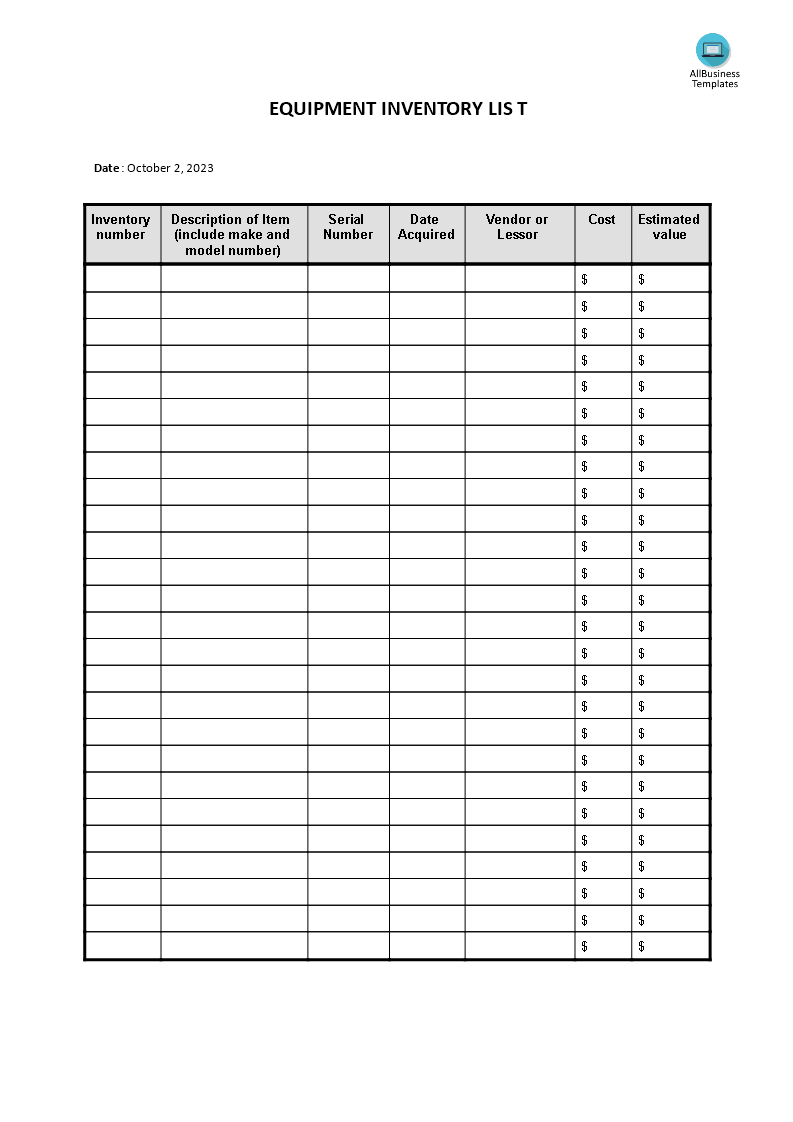Equipment inventory List Word
Save, fill-In The Blanks, Print, Done!

Download Equipment inventory List Word
Microsoft Word (.docx)Or select the format you want and we convert it for you for free:
- This Document Has Been Certified by a Professional
- 100% customizable
- This is a digital download (27.91 kB)
- Language: English
- We recommend downloading this file onto your computer.
Do you need an Equipment inventory list in MS Word? What is the basic inventory list of equipment? Download this template which allows you to easily keep track of all your equipment and assets. It includes fields for serial numbers, manufacturer, model, and purchase price. You can also customize the template to fit your specific business needs. Download this ready-made template now and get started!
An equipment inventory list, also known as an equipment inventory register or equipment inventory log, is a comprehensive record or database that contains detailed information about all the equipment and assets owned, used, or maintained by an organization, business, or individual. The purpose of an equipment inventory list is to keep track of valuable assets, monitor their status, and facilitate efficient management of these assets.
Here are the key components typically found in an equipment inventory list:
- Item Details: Each equipment item in the list is identified with a unique item or asset number. This number helps in easy tracking and referencing.
- Description: A brief description of the equipment, including its make, model, and any relevant specifications or features.
- Quantity: The number of each equipment item in stock or in use.
- Serial Number: Serial numbers are crucial for tracking and identifying individual pieces of equipment, especially in cases where there are multiple units of the same type.
- Date of Acquisition: The date when the equipment was acquired or purchased.
- Purchase Price: The cost at which the equipment was acquired. This information is essential for accounting and financial purposes.
- Location: The physical location of the equipment, which could be a specific building, room, or department. This helps in finding equipment quickly.
- Condition: The current condition or status of the equipment, which could be categorized as new, used, in good condition, in need of repair, etc.
- Maintenance Records: Details of any maintenance or repair work performed on the equipment, including dates, service providers, and costs.
- Depreciation Information: Information regarding the depreciation of equipment over time, which is important for financial reporting and tax purposes.
- User/Assignee: The name or department responsible for the equipment, including the person or team who is currently using or in charge of it.
- Disposal Information: When an equipment item is no longer in use, it should include details about its disposal, such as the date it was retired or sold, and any revenue generated from its disposal.
- Warranty Information: Information about any existing warranties or service agreements related to the equipment.
An equipment inventory list is an essential tool for asset management, maintenance planning, budgeting, and compliance with regulatory requirements. It helps organizations ensure that their assets are accounted for, properly maintained, and utilized efficiently, ultimately contributing to cost control and operational effectiveness.
Download this professional Equipment inventory list template now!
For more business templates? Just browse through our database and website! You will have instant access to thousands of free and premium business templates, legal agreements, documents, forms, letters, reports, plans, resumes, etc., which are all used by professionals in your industry. All business templates are ready-made, easy to find, wisely structured, and intuitive.
DISCLAIMER
Nothing on this site shall be considered legal advice and no attorney-client relationship is established.
Leave a Reply. If you have any questions or remarks, feel free to post them below.
Related templates
Latest templates
Latest topics
- GDPR Compliance Templates
What do you need to become GDPR compliant? Are you looking for useful GDPR document templates to make you compliant? All these compliance documents will be available to download instantly... - Google Docs Templates
How to create documents in Google Docs? We provide Google Docs compatible template and these are the reasons why it's useful to work with Google Docs... - IT Security Standards Kit
What are IT Security Standards? Check out our collection of this newly updated IT Security Kit Standard templates, including policies, controls, processes, checklists, procedures and other documents. - Letter Format
How to format a letter? Here is a brief overview of common letter formats and templates in USA and UK and get inspirited immediately! - Google Sheets Templates
How to work with Google Sheets templates? Where to download useful Google Sheets templates? Check out our samples here.
cheese

